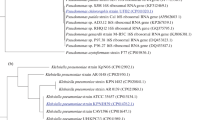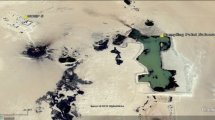Abstract
Aerobic bacteria degrading o-nitrobenzaldehyde (ONBA) were isolated from activated sludges. One of the isolates, ONBA-17, was identified as Pseudomonas sp. The isolate could grow on ONBA as its sole source of carbon and nitrogen. Further studies demonstrated that the strain was a moderately halophilic bacterium and capable of degrading benzoic acid, 2-nitrophenol, 2-aminophenol, 4-hydroxybenzoic acid, and 4-dimetylaminobenzaldehyde. It could completely degrade 100 mg L−1 ONBA at a range of pH 6–8 in 48 h at 30°C, and up to 400 mg L−1 after 288 h. The strain showed potential to be a good candidate for biotreatment of industrial wastewaters containing ONBA due to its salt-tolerance ability, multiresistance to some heavy metals and antibiotics, and the abilities of degradation of aromatic compounds. These findings may help in developing a process for ONBA-containing industrial wastewater treatment.



Similar content being viewed by others
Literature Cited
American Public Health Association (1992) Standard methods for the examination of water and wastewater, 18th ed. Washington, DC: APHA
Blaghen M, Vidon DJ-M, El Kabbaj MS (1993) Purification and properties of mercuric reductase from Yersinia enterocolitica 138A14. Can J Microbiol 39:193–200
Booth JE, Williams JW (1984) The isolation of a mercuric ion-reducing flavoprotein from Thiobacillus ferroxidans. J Gen Microbiol 130:725–730
Miguelez E, Gilmour DJ (1994) Regulation of cell volume in the salt tolerant bacterium Halomonas elongata. Lett Appl Microbiol 19:363–365
Filali BK, Taoufik J, Zeroual Y, Dzairi FZ, Talbi M, Blaghen M (2000) Waste water bacterial isolates resistant to heavy metals and antibiotics. Curr Microbiol 41:151–156
Holt JG, Krieg NR, Sneath PHA, Staley JT, Williams ST (eds) (1994) Genus Pseudomonas. In: Bergey’s manual of determinative bacteriology, 9th ed. Baltimore: Williams & Wilkins, pp 93–94
Kamanavalli CM, Ninnekar HZ (2004) Biodegradation of DDT by a Pseudomonas Species. Curr Microbiol 48:10–13
Kargi F, Dincer AR (1996) Enhancement of biological treatment performance of saline wastewater by halophilic bacteria. Bioprocess Eng 15:51–58
Kumar S, Tamura K, Nei M (2004) MEGA3: Integrated software for Molecular Evolutionary Genetics Analysis and sequence alignment. Brief Bioinformat 5:150–163
Kushner DJ (1985) The halobacteriaceae. In: Sokatch JR, Ornston LN (eds) The bacteria, a treatise on structure and function, vol. VIII. San Diego: Academic Press, pp 171–206
Nakahara H, Ishikawa T, Sarai Y, Kondo I, Kozokue H, Silver S (1977) Linkage of mercury, cadmium and arsenate and drug resistance in clinical isolates of Pseudomonas aeruginosa. Appl Environ Microbiol 33:975–976
Palleroni NJ (1984) Family I. Pseudomonadaceae. Winslow, Broadhurst, Buchanan, Krumwiede, Rogers and Smith 1917, 555AL. In: Krieg NR, Holt JG (eds) Bergey’s manual of systematic bacteriology, vol. 1. Baltimore: Williams & Wilkins, p 146
Perei K, Rákhely G, Kiss I, Polyák B, Kovács KL (2001) Biodegradation of sulfanilic acid by Pseudomonas paucimobilis. Appl Microbiol Biotechnol 55:101–107
Sabhi Y (1990) Toxicology of heavy metals on aquatic organisms: Environmental and experimental aspects. Thesis of 3rd cycle, Ph.D., University of Mohammed V., Rabat, Morocco
Saitou N, Nei M (1987) The neighbor-joining method: a new method for reconstructing phylogenetic tree. Mol Biol Evol 4:406–425
Sarnaik S, Kanekar P (1999) Biodegradation of methyl violet by Pseudomonas mendocina MCM B-402. Appl Microbiol Biotechnol 52:251–254
Sehgal SN, Gibbons NE (1960) Effect of metal ions on the growth of Halobacterium cutirubrum. Can J Microbiol 6:165–169
Silver S, Mistra TK (1988) plasmid mediated metals resistance. Annu Rev Microbiol 42:717–743
Thompson JS, Higgins DG, Gibson TJ (1994) CLUSTAL W: improving the sensitivity of progressive multiple sequence weighing, position-specific gap penalties and weight matrix choice. Nucleic Acids Res 22:4673–4680
Wilson KH, Blitchington RB, Greene RC (1990) Amplification of bacterial 16S ribosomal DNA with polymerase chain reaction. J Clin Microbiol 28:1942–1946
Woolard CR, Irvine RL (1994) Biological treatment of hypersaline wastewater by a biofilm of halophilic bacteria. Water Environ Res 66:230–235
Acknowledgments
This work was financed by grants from the Environmental Protection Administration of Jiangsu province, China (No. 2004007), and the Science and Technology department of Jiangsu province, China (No. BS2003028).
Author information
Authors and Affiliations
Corresponding author
Rights and permissions
About this article
Cite this article
Fang-Bo, Y., Biao, S. & Shun-Peng, L. Isolation and Characterization of Pseudomonas sp. Strain ONBA-17 Degrading o-Nitriobenzaldehyde. Curr Microbiol 53, 457–461 (2006). https://doi.org/10.1007/s00284-005-0380-8
Received:
Accepted:
Published:
Issue Date:
DOI: https://doi.org/10.1007/s00284-005-0380-8




